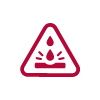5 Most Common Setbacks And Hazards In Desalination
Understanding the risks in one of the most hazardous industrial processes
Desalination is the process of removing salt and other impurities from seawater so that it can be safely consumed for industrial and residential use. This is becoming more commonplace in the wake of water shortages and a growing worldwide population.
The technology behind it is complicated and toxic and is always developing to address the setbacks it faces in order to provide safer water. Developments include Corzan® CPVC, the reliable and durable industrial piping system, engineered to meet the demands of harsh environments and rigorous processing applications.
In this blog, we discuss the five most common setbacks and hazards in desalination.
 Corrosion and Scaling
Corrosion and Scaling
Depending on what material is used, the pipes in a desalination plant can be vulnerable to scaling from the chemicals found in highly saline seawater, such as calcium and magnesium. In addition, chlorine is used in post-treatment to ensure the water is safe for use in water systems but is known to corrode both metallic and non-metallic materials.
 Leaching
Leaching
In high-pressure water distribution environments, some pipe materials are in danger of chemical leaching. This contaminates the entire water supply and threatens the safety of its users, resulting in the supply needing to be shut down.
 Temperature and Pressure
Temperature and Pressure
Some desalination plants use thermal methods which can affect the integrity of many piping systems. A newer and more effective method that is being developed is reverse osmosis, but this also creates major fluctuations in temperature and pressure. Not all materials are suitable for dealing with these extreme changes in conditions, resulting in time-consuming and costly repairs, not long into the system's life.
 Weatherability
Weatherability
Externally, desalination systems are often exposed to harsh outdoor conditions that can cause damage and corrosion. For example, desalination often occurs in coastal environments that see high wind levels. It's also developing significantly in the Middle East which sees high temperatures that cause damage alongside UV damage that causes most plastics to erode, reducing the system's ability to cope with the high-intensity pressure that desalination demands.
 Cost
Cost
Desalination plants are large and complicated, as ensuring that water is purified demands a lot from its processing materials. This, of course, means that building them is costly, but as demand increases and reverse osmosis technology develops, it's becoming more accessible. This is particularly true as Corzan CPVC pipes are being used more often as an alternative to stainless steel, offering cost savings of more than 25% compared to metal piping. This is because it is lightweight and easy to install, meaning construction costs are reduced, as well as durable and rigid so maintenance costs are lower.
Learn More
Many of these hazards can be avoided if the correct piping material is chosen.
Corzan CPVC is resistant to corrosion, scaling and UV damage. It can withstand higher pressures and has been designed for a longer lifespan alongside being recyclable. As well as all of these benefits, installation and maintenance costs are lower.
Corzan CPVC is the ultimate solution to desalination problems and is being used more often in this industry around the world. Speak to one of our representatives today